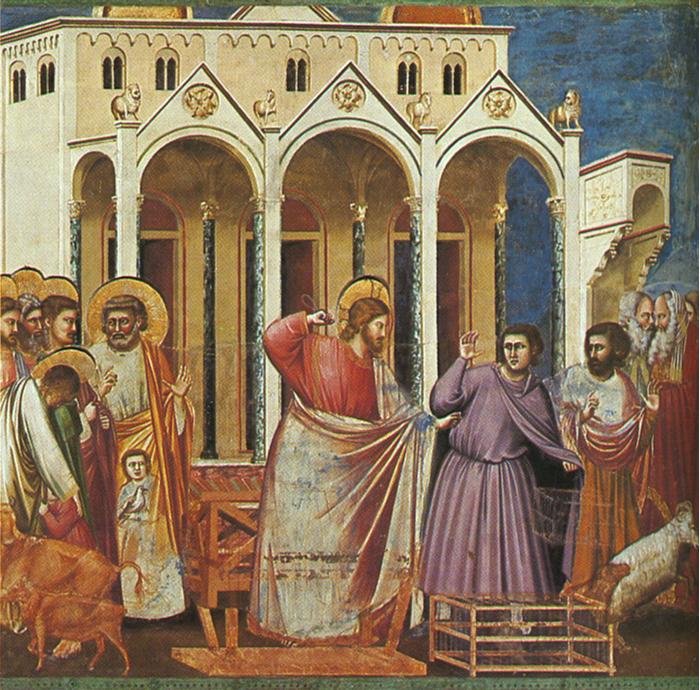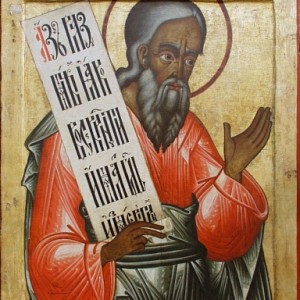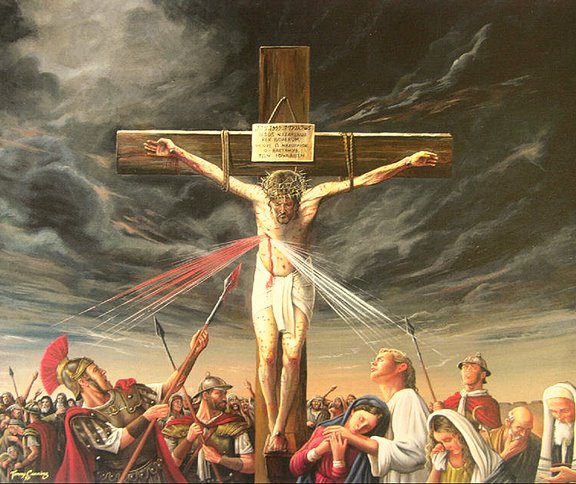Christians often approach the Temple prophesies found in Ezekiel 40-48 in one of two ways. Either they’ll conclude they’re about another literal Temple to be built in Jerusalem, rushing off to the latest ends-times theory, or they’ll write them off as hopelessly obtuse prophesy. I think Jesus makes it clear Who the Temple is, and I think that this has profound implications for how we understand Him, the Church, and His Mother.
- 597 B.C: The Babylonians depose King Jehoiachin of Judah, sending him and some of the prominent Jews (including a then twenty-five year old Ezekiel) into exile. Thus begins the Babylonian Captivity, although many Jews are still in Jerusalem.
- 592 B.C.: Ezekiel has his first prophetic experience (described in Ezekiel 1), and spends the next five years foretelling the destruction of the Temple of Jerusalem.
- 587 B.C.: The Babylonians destroy the Temple of Jerusalem (the First Temple).
- 573 B.C.: Ezekiel has the Temple visions, in “the twenty-fifth year of our exile, at the beginning of the year, on the tenth of the month, in the fourteenth year after the fall of the city” (Ezekiel 40:1).
- 538 B.C.: The Babylonian Captivity ends. Ezekiel is dead by this point, but the events are described in the Book of Daniel.
In other words, at the time Ezekiel is prophesying and writing, Israel is being crushed by the Babylonians and driven into exile. And these final eight chapters in particular are written after Jerusalem is destroyed, and all looks lost for the Jewish people. So Ezekiel’s Temple vision is important because, if nothing else, it’s God showing His people that the fight isn’t over, and that they’ll come out triumphant.
The visions Ezekiel receives are of a Temple far more incredible than the one that they lost in 587 B.C. In fact, the Temple has some apparently supernatural properies: the cleansing waters flowing from its east side even turned salt water fresh (Ezekiel 47:8). So when the Jews were finally returned from exile, they were quite reasonably excited about the new Temple. But after their return, they’re instructed to build a Second Temple that’s apparently inferior to the First. In fact, even as the crowds are cheering the groundbreaking of the Second Temple, “many of the priests and Levites and heads of fathers’ households, the old men who had seen the first temple, wept with a loud voice when the foundation of this house was laid before their eyes” (Ezra 3:12). This Second Temple was not the great Temple Ezekiel had described.
But God hadn’t broken His promises. In fact, He acknowledged that this Second Temple appeared inferior to the First, but promised it would be destined for greater glory, and that He remained faithful to what He had promised (Haggai 2:1-9):
On the twenty-first of the seventh month, the word of the LORD came by Haggai the prophet saying, “Speak now to Zerubbabel the son of Shealtiel, governor of Judah, and to Joshua the son of Jehozadak, the high priest, and to the remnant of the people saying, ‘Who is left among you who saw this temple in its former glory? And how do you see it now? Does it not seem to you like nothing in comparison? But now take courage, Zerubbabel,’ declares the LORD, ‘take courage also, Joshua son of Jehozadak, the high priest, and all you people of the land take courage,’ declares the LORD, ‘and work; for I am with you,’ declares the LORD of hosts. ‘As for the promise which I made you when you came out of Egypt, My Spirit is abiding in your midst; do not fear!’
For thus says the LORD of hosts, ‘Once more in a little while, I am going to shake the heavens and the earth, the sea also and the dry land. I will shake all the nations; and they will come with the wealth of all nations, and I will fill this house with glory,’ says the LORD of hosts. ‘The silver is Mine and the gold is Mine,’ declares the LORD of hosts. ‘The latter glory of this house will be greater than the former,’ says the LORD of hosts, ‘and in this place I will give peace,’ declares the LORD of hosts.”
As time goes on, this prophesy starts to become clearer. From Malachi we can say both why the Second Temple would be greater than the First, and how the Lord intended to fill His House with glory: by entering the Temple Himself: “Then suddenly the Lord you are seeking will come to His Temple; the messenger of the covenant, whom you desire, will come” (Malachi 3:1). It’s in Jesus Christ that God fulfills both these Second Temple prophesies, and the Temple Prophesies of Ezekiel.
 |
| Giotto, Casting Out the Money Changers (14th century). |
Jesus Christ IS the LORD of host. And He fulfills the prophesies in Haggai 2:1-9 and Malachi 3:1 by visiting the Second Temple in Person. He first went as an Infant, where He’s blessed by Simeon (Luke 2:27-35), and by the age of twelve, it was here that He taught the scholars of the law (Lk. 2:46-47). As an adult, He purified the Temple, and in the process, referred to the Temple as “My House” (Matthew 21:12-13). He then proceeded to teach from the Temple courts (Mt. 21:23). Because this is the Temple that the Incarnate Christ frequented, it possessed the Glory of the LORD in a way that the first Temple didn’t.
But even as He purifies and glorifies the Second Temple, He shows Himself to be the greater Temple: the One that Ezekiel prophesied. He returns to this theme repeatedly. In Matthew 12:6, He makes the shocking claim, “I tell you that something greater than the temple is here” before declaring Himself “Lord of the Sabbath” (Mt. 12:8). It’s hard for modern readers to get just how shocking this claim is, but consider this: when Christ foretells the destruction of the Second Temple, the Disciples assume He’s referring to His Second Coming at the end of the world (Mt. 24:1-3).
The most important of the claims Christ makes about Himself as the Temple is found in John 2:18-22,
The Jews then responded to him, “What sign can you show us to prove your authority to do all this?”
Jesus answered them, “Destroy this temple, and I will raise it again in three days.”
They replied, “It has taken forty-six years to build this temple, and you are going to raise it in three days?” But the temple he had spoken of was his body. After he was raised from the dead, his disciples recalled what he had said. Then they believed the scripture and the words that Jesus had spoken.
This claim that would be used at Jesus’ trial to condemn Him for blasphemy, with the speakers claiming that Jesus had actually threatened to destroy the Temple Himself (Matthew 26:59-61). And it was for this claim that He was mocked from the Cross (Mt. 27:40).
But this notion that Jesus’ Body is the New Temple is an incredible one. We see it all over the place, once we know to look for it. For example, when Jesus died on the Cross, the veil of the Second Temple was torn in two (Matthew 27:51, Mark 15:38, Luke 23:45). Hebrews 10:20 specifically cites to this torn veil as a symbol of the opening of Heaven, in that “we have confidence to enter the Most Holy Place by the Blood of Jesus, by a new and living way opened for us through the curtain, that is, His Body.” So that’s yet another image of Christ as the New Temple.
And it’s here on the Cross that a soldier lances Jesus’ side, which flows forth Blood and water (John 19:34). Medically, this shows that He’s Dead, and probably that His pericardial sac had burst. But this also has symbolic significance (1 John 5:6-8). The water and Blood parallel Baptism and the Eucharist. This image fulfills Ezekiel’s prophesy that rivers of saving waters will flow forth from the side of the Temple: “Swarms of living creatures will live wherever the river flows. There will be large numbers of fish, because this water flows there and makes the salt water fresh; so where the river flows everything will live” (Ezekiel 47:9). Indeed, the saving waters are seen both in the waters showing up that Christ’s saving Death on the Cross was accomplished, and in the waters of Baptism by which we’re saved (1 Peter 3:21).
Fascinatingly, Jesus actually hints at all of this early on, in John 7:37-38. I’ll let Mark Shea explain:
So, during the Feast of Tabernacles, Jesus announces to the crowd, “If any one thirst, let him come to me and drink. He who believes in me, as the scripture has said, ‘Out of his heart shall flow rivers of living water’” (Jn 7:37-38). As we already know, Jesus uses the image of living water to refer to the Holy Spirit (cf. Jn 4). Yet curiously, there’s no passage in Old Testament Scripture that says, “Out of his heart shall flow rivers of living water.” What, then, is Jesus referring to?
He is referring to Ezekiel 47 and following. After all, Jesus has already told us what the true temple is when He declared, “Destroy this temple, and in three days I will raise it up” (Jn 2:19). As John makes crystal clear, “He spoke of the temple of his body” (Jn 2:21). So Jesus is declaring to all at the Feast of Tabernacles that Ezekiel’s vision is not a physical description of a stone building, but a spiritual description of the true temple, the Body of Christ. For the same reason, John says that Jesus “tabernacled” among us (Jn 1:14) when He became man. Paul makes the same connection, referring both to individual Christians and to the mystical Body of Christ as the temple (1 Cor 3:16-17; Eph 2:21).
Hopefully, you’ve noticed that Ezekiel’s references to the New Temple don’t just prefigure Christ’s physical Body. They also prefigure His Mystical Body, the Church (Romans 12:5; 1 Corinthians 12:12, 27). His physical Body flowed forth the waters from His Heart, burst with love; His Mystical Body flows forth the waters of Baptism, from the heart of the Church.
Given all of this, I wanted to focus on the Marian implications as well, based on a question I’d received on that recently. Saturday’s post showed how Scripture presents Mary as the Ark of the New Covenant, with her visitation of Elizabeth (Luke 1:39-56) a remarkable parallel to the Ark of the Covenant’s visitation of Obededom (2 Samuel 6:2-14). But what do we mean when we call her the Temple Gate? It’s a reference to a specific part of Ezekiel’s prophesy (Ez.44:1-2):
Then the man brought me back to the outer gate of the sanctuary, the one facing east, and it was shut. The LORD said to me, “This gate is to remain shut. It must not be opened; no one may enter through it. It is to remain shut because the LORD, the God of Israel, has entered through it.
If Jesus Christ is the Temple, who or what is the Temple Gate? It’s Mary. Mary is the Gate through which Jesus entered the world. John 1:14 says Jesus “tabernacled” among us. This was first accomplished inside Mary’s womb, just as the gate surrounds the Temple where the tabernacle is stored. She was given the astonishing task to nurture, guard, and nourish the omnipotent God of the Universe in her womb, where He dwelt for nine months. At His most vulnerable, as a tiny Fetus, He chose to rely on her.
Of course, if Mary is the Temple Gate, the obvious implication of Ezekiel 44:1-2 would be that she was permanently consecrated to God in a very particular way, a way that necessitated her perpetual Virginity. No one else entered the world through the Temple Gate. Here’s where it gets interesting. It so happens that the Apostles taught that Mary was, in fact, a perpetual Virgin, if the earliest Christians can be trusted. Shea again:
Patristic sources who affirm that Mary’s perpetual virginity was taught by the apostles include the author of the Protoevangelium of James, Origen, Hilary of Poitiers, Athanasius, Epiphanius of Salamis, Jerome, Didymus the Blind, Ambrose of Milan, Pope Siricius I, Augustine, Leporius, Cyril of Alexandria, Pope Leo I, and the dogmatic teaching of the Second Ecumenical Council of Constantinople. And they’re only the beginning.
All of this starts to fit together neatly. Jesus’s Body (both Physical and Mystical) is the Temple. Mary is the Temple Gate, since she’s our Theotokos (God-bearer), to borrow the title used to refer to her at the Council of Ephesus in 431.
But this suggests something more: not only is Mary pure and consecrated to God in a particular way, but she’s also a mother and protector. Gates aren’t just containers, they’re defensive fortifications. And that gets us back to passages like Revelation 12, where we see the Mother of Jesus in Heaven (Rev. 12:1-5), as part of some pretty epic spiritual warfare against the devil. Satan keeps attacking Mary, who remains supernaturally protected from his advances (Rev. 12:13-16), which comports with the whole Catholic belief that she was kept free from sin . When the devil can’t get to Mary, he goes for us: “Then the dragon was enraged at the woman and went off to make war against the rest of her offspring—those who obey God’s commandments and hold to the testimony of Jesus” (Rev. 12:17). This certainly looks like Scripture is depicting Mary as a mother and a sure defense for Christians.






54 comments